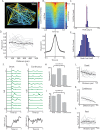Coordination of rapid cholinergic and dopaminergic signaling in striatum during spontaneous movement
- PMID: 30920369
- PMCID: PMC6457892
- DOI: 10.7554/eLife.44903
Coordination of rapid cholinergic and dopaminergic signaling in striatum during spontaneous movement
Abstract
Interplay between dopaminergic and cholinergic neuromodulation in the striatum is crucial for movement control, with prominent models proposing pro-kinetic and anti-kinetic effects of dopamine and acetylcholine release, respectively. However, the natural, movement-related signals of striatum cholinergic neurons and their relationship to simultaneous variations in dopamine signaling are unknown. Here, functional optical recordings in mice were used to establish rapid cholinergic signals in dorsal striatum during spontaneous movements. Bursts across the cholinergic population occurred at transitions between movement states and were marked by widespread network synchronization which diminished during sustained locomotion. Simultaneous cholinergic and dopaminergic recordings revealed distinct but coordinated sub-second signals, suggesting a new model where cholinergic population synchrony signals rapid changes in movement states while dopamine signals the drive to enact or sustain those states.
Keywords: acetylcholine; dopamine; in vivo; motor control; mouse; neuroscience; optical recording; striatum.
© 2019, Howe et al.
Conflict of interest statement
MH, IR, AA, AL, MA, DD No competing interests declared
Figures














References
-
- Aosaki T, Tsubokawa H, Ishida A, Watanabe K, Graybiel AM, Kimura M. Responses of tonically active neurons in the primate's striatum undergo systematic changes during behavioral sensorimotor conditioning. The Journal of Neuroscience. 1994a;14:3969–3984. doi: 10.1523/JNEUROSCI.14-06-03969.1994. - DOI - PMC - PubMed
Publication types
MeSH terms
Associated data
Grants and funding
LinkOut - more resources
Full Text Sources
Other Literature Sources
Molecular Biology Databases

